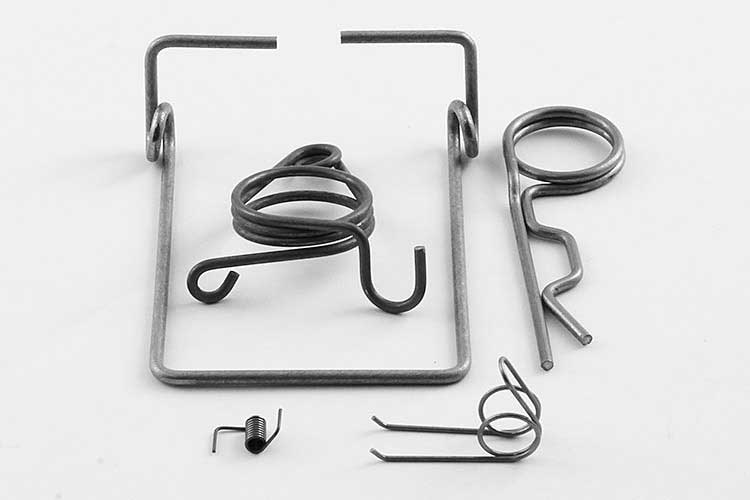Get unique, complex parts easily. No matter your requirements, Chaoyi Spring creates hard-to-produce coil springs and wire forms.
Let us help you create the custom wire form you need, from S-hooks and J-hooks to utility hooks and more.
We work closely with customers across a wide range of industries, helping them design and manufacture made-to-order parts.
Why choose Chaoyi Spring? We prioritize customer-focused collaboration, modern equipment and the latest technology to make your parts per print.
Find the information and guidance you need, from measuring a spring to learning about materials, placing an order and much more.
In the world of mechanical engineering, springs are ubiquitous elements that play a crucial role in various applications. From the simple act of opening a door to the intricate workings


In the world of mechanical engineering, springs are ubiquitous elements that play a crucial role in various applications. From the simple act of opening a door to the intricate workings of complex machinery, springs provide essential force and movement. Two fundamental types of springs, torsion springs and tension springs, are often encountered in countless designs. While both are capable of storing and releasing energy, they differ significantly in their operational mechanisms and applications. This article delves into the distinct characteristics of torsion springs and tension springs, elucidating their differences and highlighting their respective suitability for specific engineering tasks.

The primary distinction between torsion springs and tension springs lies in their fundamental function. Torsion springs, as their name suggests, are designed to resist and generate torque. They store energy when twisted or rotated, and when released, they exert a restoring force that attempts to return the spring to its original position. Think of a door hinge – the torsion spring within the hinge stores energy as the door is opened and then releases that energy, allowing the door to close. In contrast, tension springs work by resisting stretching or pulling forces. They store energy when stretched, and upon release, they contract, generating a pulling force. Imagine a spring-loaded retractable pen – the tension spring inside is stretched when the pen is extended and then contracts, pulling the pen back into its closed state.
Torsion springs are typically helical in shape, resembling a coil. They are often made from materials like steel, spring wire, or music wire, chosen for their high resilience and resistance to fatigue. When subjected to a twisting force, the spring stores energy within its coils. The amount of torque the spring can store depends on factors like its material, diameter, number of coils, and the angle of twist. Torsion springs are employed in various applications, including:
Tension springs, like torsion springs, are typically helical in shape. They are often manufactured from materials like steel, music wire, or phosphor bronze, selected for their ability to withstand stretching forces. When a tension spring is stretched, it stores energy within its coils. The amount of force the spring can store depends on factors like its material, diameter, number of coils, and the extent of stretching. Tension springs are used in a wide array of applications, including:
To further understand the differences between torsion springs and tension springs, let's compare some key characteristics:
| Characteristic | Torsion Spring | Tension Spring |
|---|---|---|
| Function | Resists and generates torque | Resists stretching and pulling forces |
| Energy Storage | Stores energy when twisted | Stores energy when stretched |
| Force Output | Rotational force | Linear force |
| Applications | Door hinges, automotive suspension, clock mechanisms | Retractable pens, clothesline mechanisms, mechanical clamps |
The selection of either a torsion spring or a tension spring for a specific application depends on the desired function, force requirements, and design constraints. If the application necessitates a rotational force or the resistance of twisting motion, a torsion spring would be the ideal choice. Conversely, if a linear force or the resistance of stretching is needed, a tension spring would be more suitable. Consider factors like the force required, the space available for the spring, and the desired spring rate (the relationship between force and displacement) when making your decision.
Torsion springs and tension springs are essential components in countless mechanical systems. While both serve the purpose of storing and releasing energy, their unique mechanisms and applications differentiate them. By understanding the fundamental characteristics of each type, engineers and designers can select the most appropriate spring to meet their specific design requirements, ensuring optimal performance and functionality in their projects.
Whether it's a simple door hinge or a complex mechanical assembly, torsion springs and tension springs play crucial roles in our daily lives. By grasping the core differences and applications of these springs, we can appreciate their importance in modern technology and engineering. Remember, when choosing between a torsion spring and a tension spring, carefully consider the function, force requirements, and design constraints of your project. This will ensure that you select the right spring for optimal performance and a successful outcome.
Browse some of the custom wire forms and springs that we manufacture. Don’t see what you need? We specialize in made-to-order products that meet your application requirements.
Visit Our GalleryNeed a custom wire form or coil spring? We make it work. Fill out the contact form and a representative will respond within 1 business day. If you have a PDF or CAD file, you can submit to request a quote.